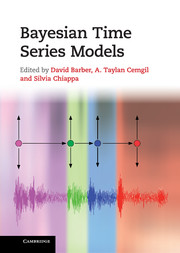Book contents
- Frontmatter
- Contents
- List of contributors
- Preface
- 1 Inference and estimation in probabilistic time series models
- I Monte Carlo
- II Deterministic approximations
- III Switching models
- 9 Physiological monitoring with factorial switching linear dynamical systems
- 10 Analysis of changepoint models
- IV Multi-object models
- V Nonparametric models
- VI Agent-based models
- Index
- Plate section
- References
10 - Analysis of changepoint models
from III - Switching models
Published online by Cambridge University Press: 07 September 2011
- Frontmatter
- Contents
- List of contributors
- Preface
- 1 Inference and estimation in probabilistic time series models
- I Monte Carlo
- II Deterministic approximations
- III Switching models
- 9 Physiological monitoring with factorial switching linear dynamical systems
- 10 Analysis of changepoint models
- IV Multi-object models
- V Nonparametric models
- VI Agent-based models
- Index
- Plate section
- References
Summary
Introduction
Many time series are characterised by abrupt changes in structure, such as sudden jumps in level or volatility. We consider changepoints to be those time points which divide a dataset into distinct homogeneous segments. In practice the number of changepoints will not be known. The ability to detect changepoints is important for both methodological and practical reasons including: the validation of an untested scientific hypothesis [27]; monitoring and assessment of safety critical processes [14]; and the validation of modelling assumptions [21].
The development of inference methods for changepoint problems is by no means a recent phenomenon, with early works including [39], [45] and [28]. Increasingly the ability to detect changepoints quickly and accurately is of interest to a wide range of disciplines. Recent examples of application areas include numerous bioinformatic applications [37, 15], the detection of malware within software [51], network traffic analysis [35], finance [46], climatology [32] and oceanography [34].
In this chapter we describe and compare a number of different approaches for estimating changepoints. For a more general overview of changepoint methods, we refer interested readers to [8] and [11]. The structure of this chapter is as follows. First we introduce the model we focus on. We then describe methods for detecting a single changepoint and methods for detecting multiple changepoint, which will cover both frequentist and Bayesian approaches.
- Type
- Chapter
- Information
- Bayesian Time Series Models , pp. 205 - 224Publisher: Cambridge University PressPrint publication year: 2011
References
- 62
- Cited by

